What is the flavor of Colombian coffee bred by volcanic soil? Colombian coffee treatment
Professional coffee knowledge exchange more coffee bean information please follow the coffee workshop (Wechat official account cafe_style)
Colombia sits on a heaven-given mountain with good water, rich landforms, clusters of volcanoes, fertile soil and abundant Rain Water. Qianjie believes that this is a heaven-made coffee wonderland. From 2008 to 2011, Colombian coffee beans won the SCAA cup test for four years in a row, which is more eye-catching than the three consecutive years of winning the Panama Rose Summer Coffee BOP Cup contest since 2004, as mentioned in the previous article.
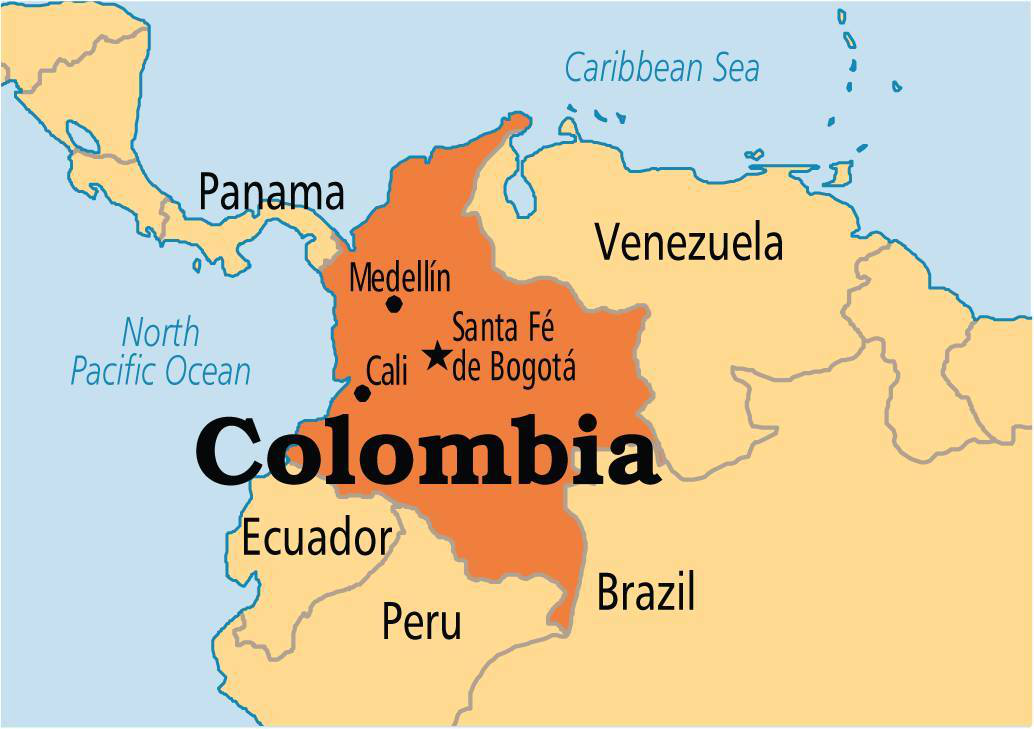
Colombia spans the northern and southern hemispheres, and the coffee planting zone is mainly distributed between 2-8 degrees north latitude. From north to south, each producing area has two major harvest periods because of Rain Water. The main harvest period is from October to February of the following year, and the second harvest period is from April to September. In other words, Colombian coffee is harvested all the year round, and Colombia does not grow robusta coffee beans. This also brings the annual output of Colombian Arabica coffee to 12000000 bags (one bag weighs about 60-70kg), making Colombia the second largest Arabica producer.
Colombian coffee producing area
Colombian coffee production area is divided into two parts, one is located in central Colombia, the main producer of coffee beans, low altitude, about 1000m. The region known as MAM,M refers to Medlillin, the capital of Antioquia, A refers to Armenia, the holy capital of Kindio, and an M refers to Manizales, the capital of Calda province. The coffee beans produced in the middle of the central region are low-sour, mellow and sweet, a bit close to the flavor of Indonesia's Mantenin.
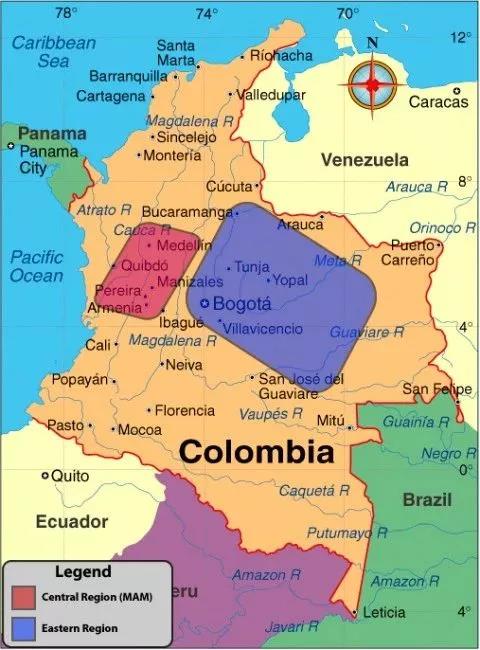
Part of it is in south-central Colombia, where the best coffee beans of the year for all previous SCAA years come from. Here is full of volcanoes, is a Crouching Tiger Hidden Dragon boutique coffee bean producing area. The region includes the provinces of Tolima (Tolima), Cauca (Cauca), Huilan (Huila) and Nalinglong (Naeino).
Huilan Province (Huila)
Located in the southern part of the Central Mountains in southern Colombia, it is the most famous boutique coffee producing area in the country. This area is a hilly land surrounded by mountains, planted more than 1500 meters above sea level, where the most important rivers in Colombia meet, bringing abundant water resources and moisture. Compared with the general impression that a large amount of Colombian coffee is balanced and mellow, the fine Goran products produced by many small farmers in micro batches are actually very characteristic of the flavor of the producing area.
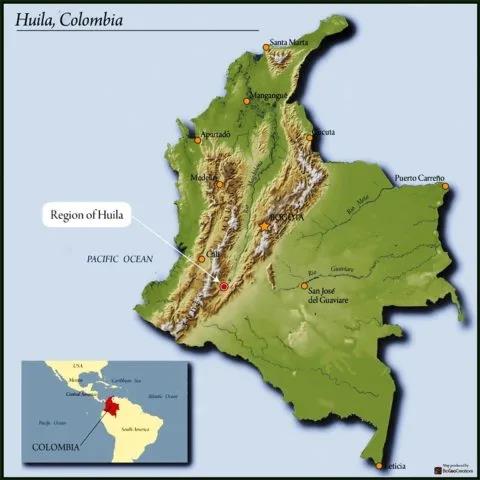
In recent years, with the attention to the quality of coffee in the international market and the demand for Colombian boutique coffee, the original bean size grading system has been gradually abandoned to micro-batch (Micro-regional selections) provided by small farmers in micro-production areas, and dozens of small farmers have provided their unit harvest into a micro-batch to sell, so they have more opportunities to measure by batch-by-cup. Directly pick out a lot of high-quality specific smallholder coffee.
Tolima province (Tolima)
Adjacent to Huilan and Cauca, there are the north-south Andes (M. Andes) and the Cordillera (M. Cordillera), and between the two famous mountain systems is the Magdalena River (R. Magdalena) running from south to north. The name Tolima comes from the earliest people who lived here, "Pijaopeople". In the language of this ancient people (Pijao word), tolima means "snow cover" and "snowed". The farms in Tolima are generally slightly larger than those in other southern Colombian producing areas, ranging from 10 to 15 hectares. The cooperative approach is also popular here, where farmers send their small batches of fresh coffee and fruit to the cooperative's processing plant. Some farmers will also choose to deal with it on their own, making use of their own small-scale treatment facilities that can handle the harvest of the day.
Cauca province (Cauca)
It is a certified coffee producing area in Colombia, with an average elevation of 1758m, and the highest elevation can rise to 2100m. The topography, precipitation, temperature and volcanic soil of the area prepare suitable conditions for coffee growth. 80% are mountainous, with parallel mountain systems in the east and middle, part of the Andes.
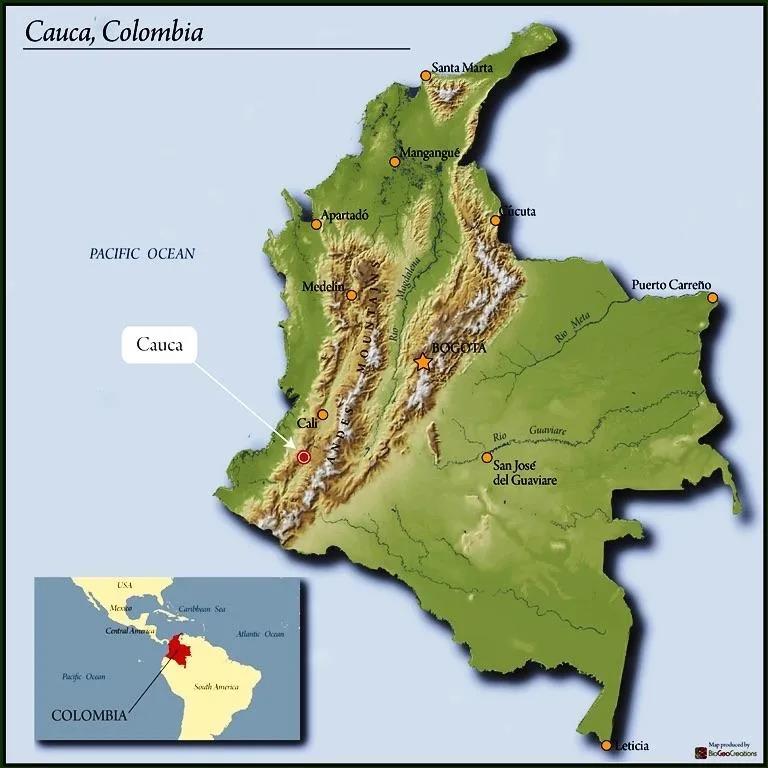
The central mountain system includes two major volcanoes, Sotara and Petacas. Cauca province on the border is similar to other southwestern producing areas, with an obvious unimodal precipitation distribution (monomodal). The dry season mainly occurs from August to September every year, followed by a concentrated coffee blossom season followed by the next year's concentrated coffee harvest season.
Na Linglong Province (Narino)
Located in the southwest of the country, facing the Pacific Ocean to the west and Ecuador (Ecuador) to the south, the Andes Mountains run through the province. Coffee is grown on a high-altitude cloud belt of 1600 Murray 2300. The soil is fertile volcanic geology, small but full beans and green color. Most of the annual output of Nalinglong is purchased by large American soybean merchants. Narino province is located in the southwest of Colombia, bordering by the Pacific Ocean to the west and neighboring Ecuador (Ecuador) to the south, the Andes Mountains run through the province, where there are magnificent mountains and beautiful scenery, and there are many rivers flowing south through this area, belonging to Colombia's alpine coffee growing area, which has given birth to many small farmers of fine coffee. The total annual output of that Linglong province is about 150000 bags, while the part that belongs to fine beans is only about 6000 bags.
Volcanic ash adds flavoring alcohol to Colombian coffee beans.
Huilan Volcano has been revived since 2008, spewing out a lot of mud and ash, but fortunately not magma. Local coffee farmers not only do not worry, on the contrary, they hope that the mud can be spewed out all the time, because the volcano will be rich in minerals, nourish the coffee fields and help breed more flavor and aroma of coffee. Some coffee farmers even attribute volcanic ash to the frequent championships of Colombian coffee after 2008.
Grow coffee varieties
Any coffee variety that is difficult to care for becomes comfortable in the promised land of Colombia, including iron pickup, bourbon, Kaddura, Pacamara, Rosa and so on. Due to the fertile soil and the great temperature difference between day and night, Kaddura, who could not live in Brazil, became like a fish in water in Colombia. as a result, he became the main breed in Colombia. In 1980, Colombia bred many generations of improved Cartiven varieties, bearing the national name of "Colombia" and forming a dual main variety with Kaddura. In 2002, Colombia launched the second generation of "Colombia", named Castillo, and strongly encouraged farmers to change to the new variety.
Kaddura (Caturra)
A natural variety of the Arabica variety Bourbon, it was discovered in Brazil in 1937. Its tree is not as tall as bourbon and smaller. Due to inheriting the blood of bourbon, the disease resistance is relatively weak, but the yield is higher than that of bourbon. Although found in Brazil, Kaddura is not suitable for growing in Brazil, so it is not planted on a large scale in Brazil, but is popular in Central and South America, such as Colombia, Costa Rica and Nicaragua. Kaddura is planted on a large scale.
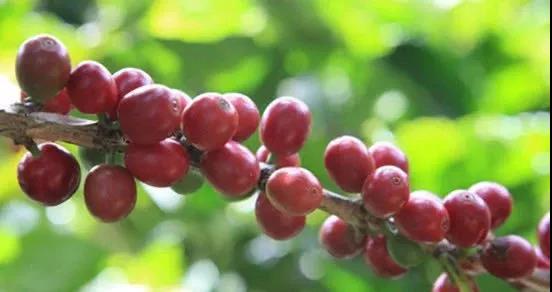
Colombia (Colombia)
The variety has Kaddura and Timo blood, also known as the notorious Katim, but [FNC] insists that although Colombia is a direct line of Katim, its flavor is far more elegant than that of ordinary Katim, because after generations of "reverse crossing" with Arabica, Colombia has washed away the moldy smell of stout beans and tastes more like Arabica, and has both disease resistance and high yield advantages of stout beans, making it a sharp weapon for Colombia to increase production.
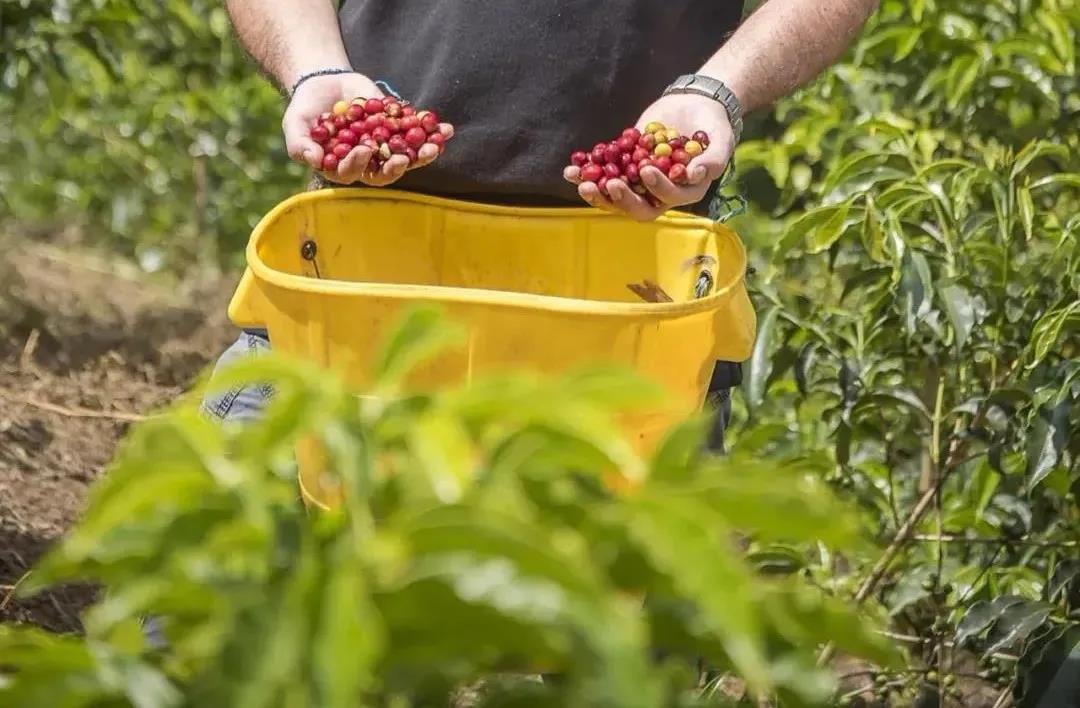
Castiao (Castillo)
It is the most widely cultivated coffee variety in Colombia and is popular because of its reputation for resistance to leaf rust. Since 1961, Cenicafe began to study the Timo variety of Robusta blood, and then Cenicafe continued its research and development. In 2002, it released a second disease-resistant variety, Tabi (a hybrid of iron pickup, bourbon and Timor), and in 2005 it released the most functional disease-resistant variety to date. After the outbreak of leaf rust in 2008, Colombia began to vigorously promote the cultivation of Castillo.
Coffee bean treatment
Colombian coffee beans are mainly treated by water washing. with the prevalence of special treatment and "no rejection" of Colombian coffee beans, more and more special treatments are applied to Colombian coffee beans, the most representative of which is anaerobic fermentation.
Washing treatment method
Washed
Coffee farmers first pour the picked coffee berries into a large tank, immature inferior beans will float to the surface, ripe and full fruits will sink to the bottom, and the defective fruits floating on the surface will be removed. Then use the pulp sieving machine to remove the outer skin and pulp of the coffee fruit, when the coffee beans are still attached to a layer of slippery pectin.

Put the coffee beans with pectin in the fermentation tank for 16 hours and 36 hours, during which the microbes will decompose the pectin. After the fermentation is completed, a large amount of water is used to remove the pectin residue from the coffee beans. Finally, the washed coffee beans are dried in the sun.
Anaerobic fermentation treatment
Anaerobic Fermentation
As a new taste experience, anaerobic fermentation can be named in many ways, many people will call it "anaerobic fermentation", some people will call it "carbon dioxide impregnation", but to put it simply, it is actually a way of fermentation in a hypoxic or anaerobic environment, usually using a stainless steel jar that can withstand pressure. You can control the fermentation by controlling the temperature, time, PH and the data you need to control the fermentation. Anaerobic fermentation is best known for anaerobic solarization and anaerobic washing.
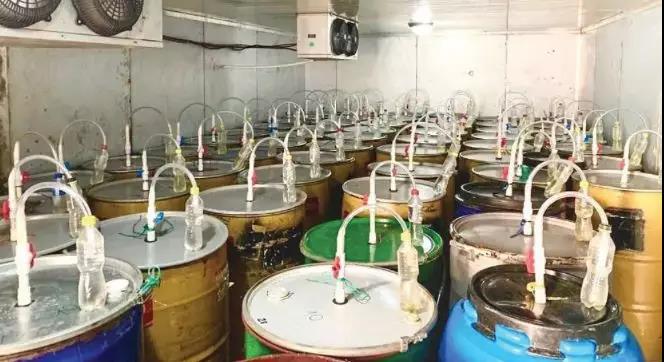
Anaerobic solarization treatment
Put the freshly harvested coffee cherries into a sealed fermentation bucket for low temperature fermentation, the temperature must be lower than 10-15 degrees Celsius. In an anaerobic environment, the decomposition rate of pectin sugar is slowed down, and the ph value decreases more slowly, prolonging the fermentation time, thus developing a better sweetness and a more balanced flavor. After more than three days of anaerobic fermentation, the coffee cherries in the bucket were sun-dried.
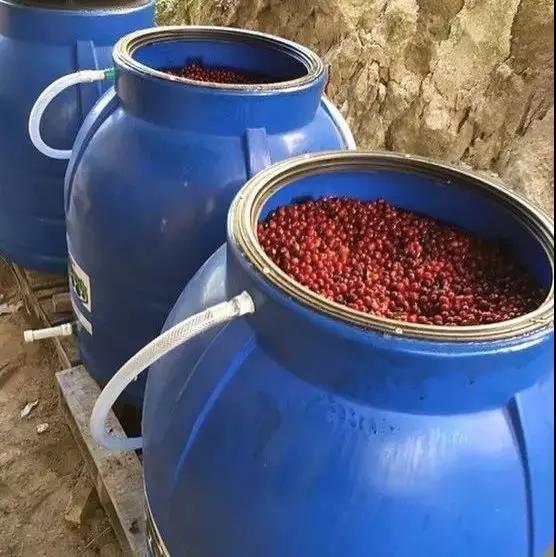
Anaerobic washing treatment
Anaerobic washing removes defective coffee beans by washing. Finally, the processed coffee beans are put into a closed container and injected with carbon dioxide to exhaust oxygen, which slows down the decomposition rate of sugar in coffee pectin in an oxygen-free environment. PH also decreases more slowly, prolonging the fermentation time, so as to develop a better sweetness and a more balanced flavor of coffee.
Anaerobic double enzyme washing: on the basis of anaerobic washing, adding special enzymes to carry out secondary anaerobic fermentation. After the coffee fruit is removed from the anaerobic environment, the peel and pulp of the coffee fruit is removed by the machine, and the coffee beans with pectin are put into an anaerobic environment in a plastic bag or other sealed container for another anaerobic fermentation. The treatment method which has experienced the above two anaerobic fermentation is called double anaerobic fermentation.
The difference between anaerobic sun-cured and anaerobic washed coffee beans
At this point of anaerobic treatment, some friends began to wonder what is the difference between anaerobic solarization and anaerobic enzyme washing. This time Qianjie used the same Kaddura variety of anaerobic sun treatment and anaerobic double enzyme to wash the rose valley for raw beans, baking, cup testing and brewing.
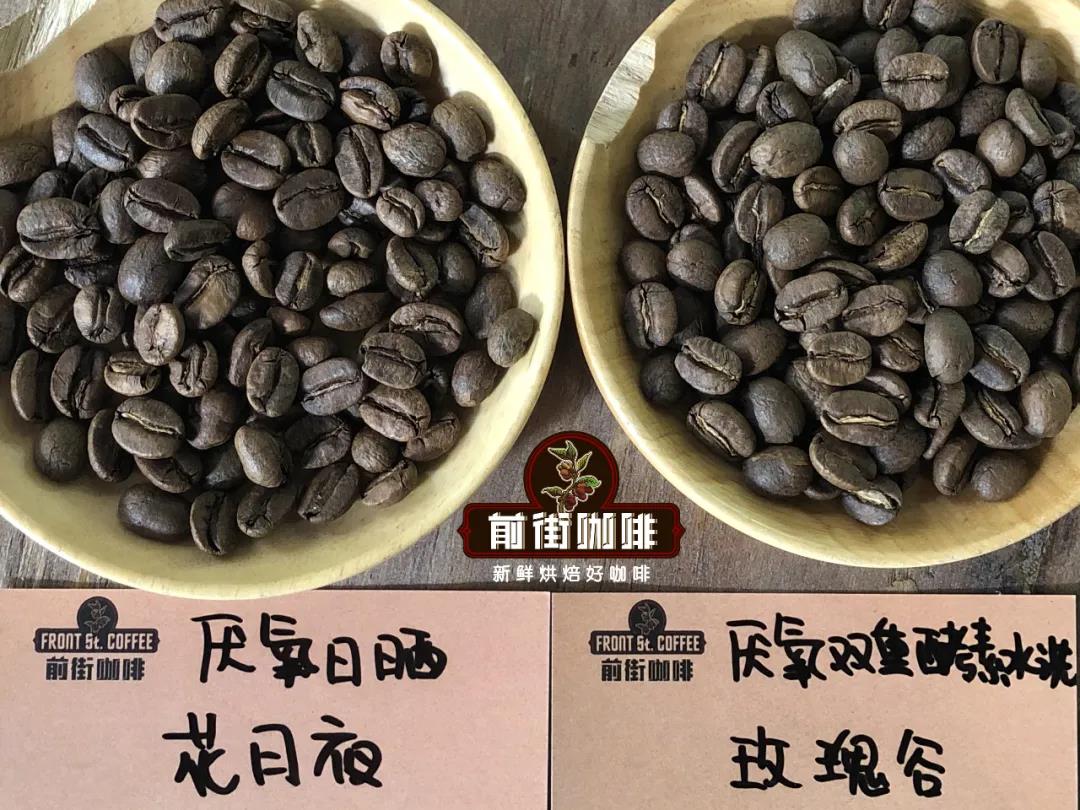
Comparison of coffee and raw beans in Qianjie
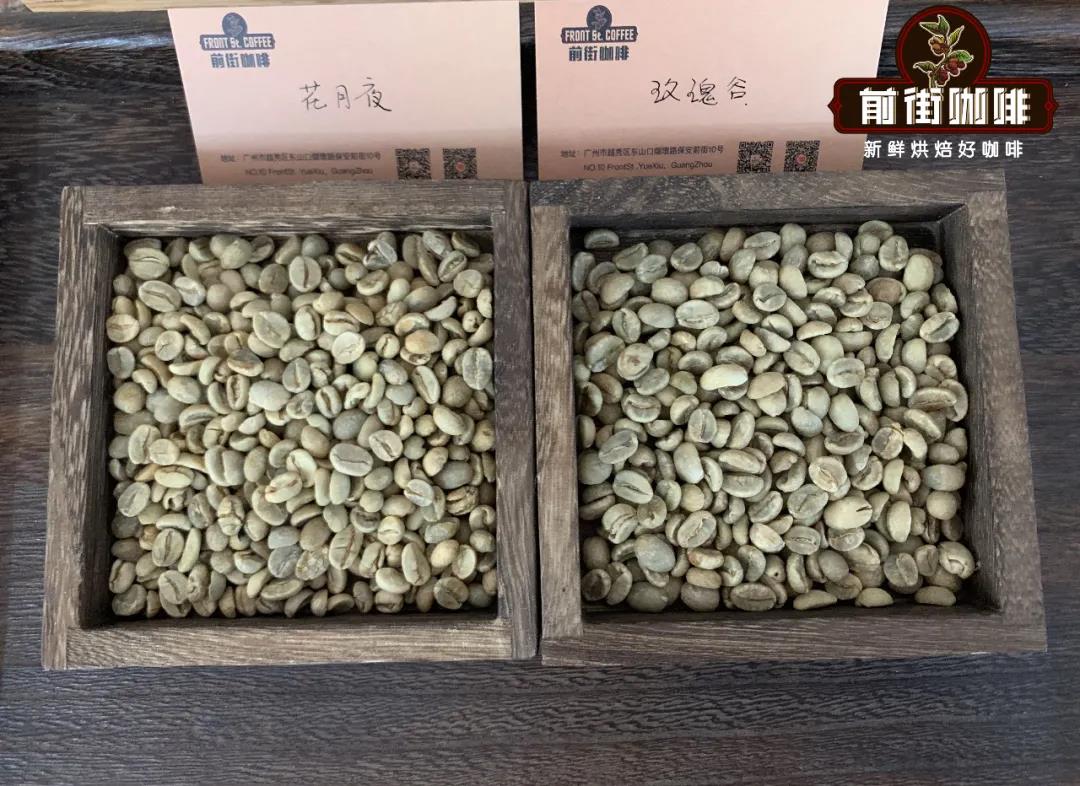
Under the condition of raw beans, the anaerobic sun-dried beans look yellowish green with more silver skin, while the anaerobic washed beans are blue-green with less silver skin. This is because the washed beans are soaked in the water for a long time, the silver skins are separated from the coffee beans, and the outer silver skins are peeled off by the way when the parchment is finally removed, and there is little silver left on the surface of the washed raw beans.
Qianjie Coffee Baking record
These two kinds of beans have high water content in the new season, and the front street baker will prolong the dehydration time during the baking process to heat the bean surface and core evenly.
Flower Moon Night Baking suggestion: considering that Columbia Flower Moon Night is an anaerobic sun treatment, moderate baking is used in order to retain the fermented feeling of beans and show full mellow thickness and sweet taste.
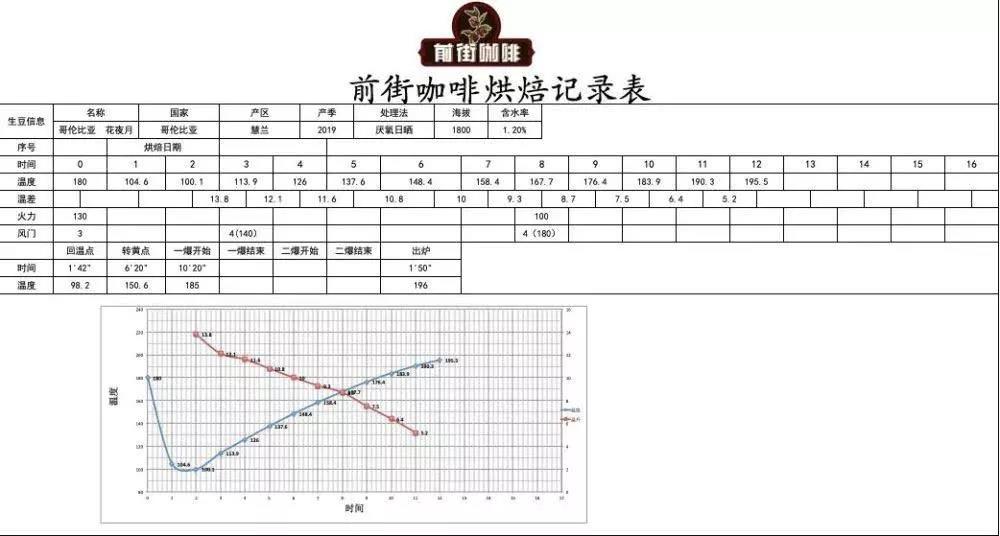
Yangjia 800N, bean dosage: 480g. Furnace temperature to 180℃ into the pot, throttle open 3, firepower is 130C; furnace temperature to 140C, throttle open 4; furnace temperature to facility 150.6 °C, turn yellow point 6pm 39t20 ", when the bean table turns yellow, the smell of grass disappears completely, enter the dehydration stage, when 180℃, the firepower drops to 100and the throttle remains unchanged. The smell of toasted bread has obviously changed to the smell of coffee, which can be defined as a prelude to an explosion. At this time, it is necessary to listen carefully to the sound of the explosion point. At this time, the sound of the explosion point will start to explode. The throttle will be fully opened. After the explosion, there will be a development of 1mm bread 39th 50 ", and 196 ℃ will be put into the pot.
Rose Valley Baking suggestion: considering that Columbia Rose Valley is a double anaerobic washing method, moderate baking is used in order to retain the fruit tone and rich acidity of beans, while showing the cleanliness of the taste and the sour and sweet flavor.
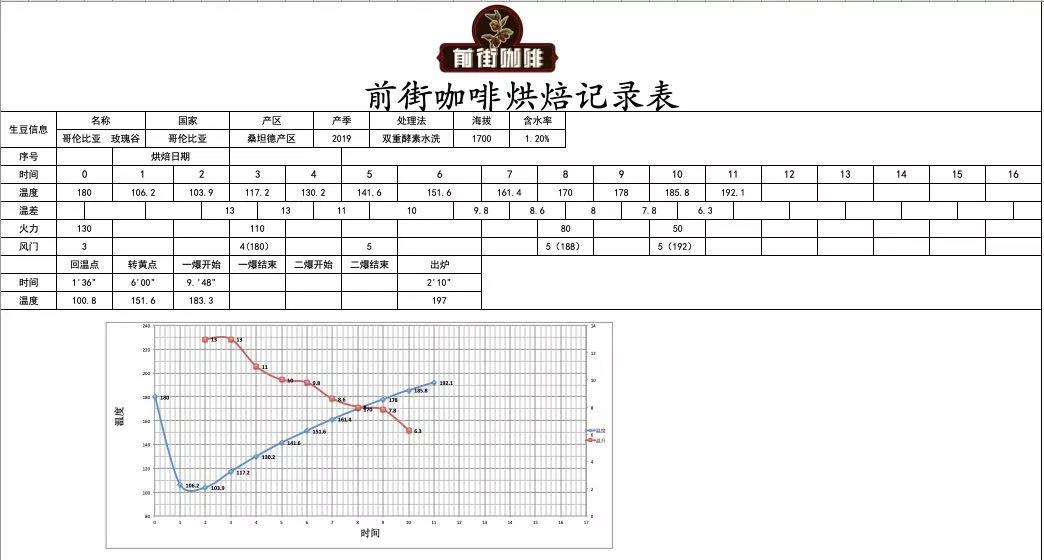
Yangjia 800N, bean dosage: 480g. When the furnace temperature reaches 180oC ℃, the throttle opens 3, the firepower is 130; the temperature recovery point is 36 "; when the furnace temperature reaches 140C, the fire throttle opens 4. When the temperature of the stove reaches 151.6 °C, the yellow point turns yellow, the smell of grass disappears completely, and enters the dehydration stage. When the temperature of the oven reaches 151.6 °C, the bean surface appears ugly wrinkles and black markings, and the smell of toast obviously turns to coffee, which can be defined as a prelude to an explosion. At this time, it is necessary to listen carefully to the sound of the explosion point. 48 "began to explode, the throttle was fully opened, and the firepower was reduced to 80 at 188 ℃. When the temperature is 192 degrees, the firepower is reduced to 50; after an explosion, the firepower is reduced to 10 ", and the boiler is put into the pot at 197 ℃.
Coffee cup test report on Qianjie
Testing the Flavor of Flower Moon Night Cup
Dry aroma: berries, nuts, fermented fragrance
Wet fragrance: berries, strawberries, chocolate
Flavor: strawberry jam, fermented wine, chocolate

Rose Valley cup test flavor:
Dry fragrance: fermentation, berries, strawberries
Wet fragrance: honey, juicy, strawberries
Flavor: rose, peach, wine heart chocolate
Qianjie coffee brewing tips
Filter cup: Hario V60 # 01
Water temperature: 90-91 ℃
Amount of powder: 15g
Powder / water ratio: 1:15
Degree of grinding: medium fine grinding / fine sugar size (80% pass rate of No. 20 screen)
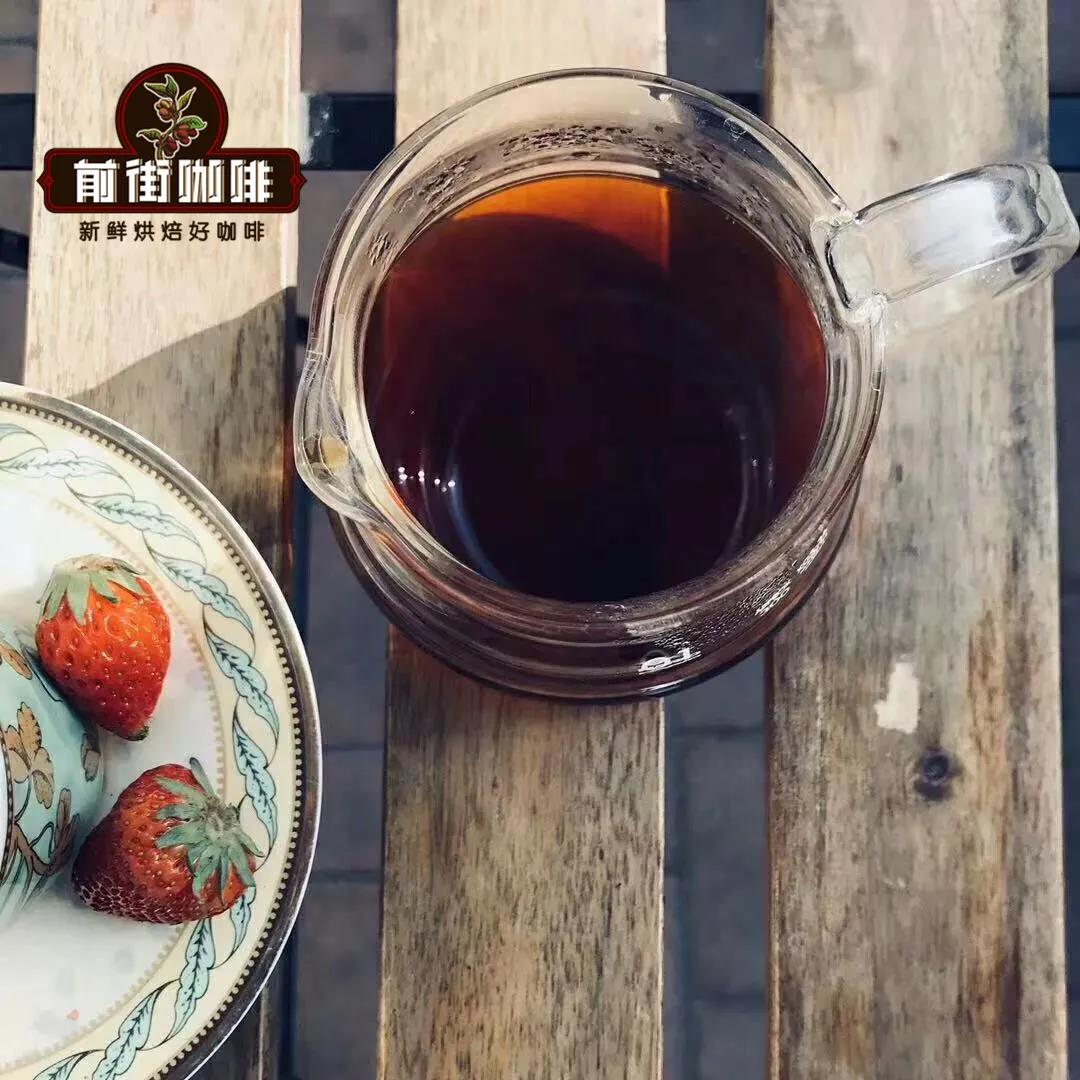
Qianjie coffee is extracted by stages, also known as three-stage brewing: steaming with 30 grams of water for 30 seconds, injecting water around a circle to 125 grams for stages, continuing to inject water to 225 grams when the water level is about to be exposed to the powder bed, removing the filter cup when the water level is about to be exposed to the powder bed, (steaming starting timing) the extraction time is 2 grams 3900 "- 2 grams 3910".
Floral flavor: intense strawberry aroma, acidity of imported strawberries, mid-jam sweetness, slight cocoa tail, juicy taste.
Rose Valley cooking flavor: the sweetness of peach, accompanied by the aromas of rose and chocolate, with the sweet and sour taste of black grapes and the silky taste of creamy toffee.
For more boutique coffee beans, please add private Qianjie coffee on Wechat. WeChat account: kaixinguoguo0925
Important Notice :
前街咖啡 FrontStreet Coffee has moved to new addredd:
FrontStreet Coffee Address: 315,Donghua East Road,GuangZhou
Tel:020 38364473
- Prev
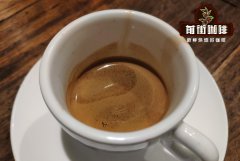
The quality of Italian coffee is unstable, which may be caused by the temperature of coffee powder.
No barista will ignore the effect of "extraction temperature" on coffee, but few people realize that the extraction temperature is actually determined by "water temperature" and "coffee powder temperature". In daily operation, it is difficult for us to have the time and energy to accurately measure the temperature of coffee powder. However, excessive heat will cause the aroma of coffee powder to volatilize ahead of time, which has become coffee.
- Next
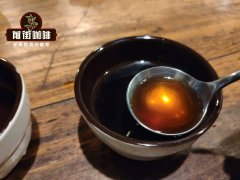
What is the Ethiopian Commodity Exchange? What role does ECX play in Ethiopian Coffee Trade
The Ethiopian Commodity Exchange (ECX) is the national multi-commodity exchange in Ethiopia, through which most of the country's coffee is traded. Since its establishment in 2008, it has been the subject of praise and criticism in the entire coffee industry. Although adjustments have been made to the way ECX operates, the views of the industry as a whole remain uneven. For people outside Ethiopia
Related
- Beginners will see the "Coffee pull flower" guide!
- What is the difference between ice blog purified milk and ordinary milk coffee?
- Why is the Philippines the largest producer of crops in Liberia?
- For coffee extraction, should the fine powder be retained?
- How does extracted espresso fill pressed powder? How much strength does it take to press the powder?
- How to make jasmine cold extract coffee? Is the jasmine + latte good?
- Will this little toy really make the coffee taste better? How does Lily Drip affect coffee extraction?
- Will the action of slapping the filter cup also affect coffee extraction?
- What's the difference between powder-to-water ratio and powder-to-liquid ratio?
- What is the Ethiopian local species? What does it have to do with Heirloom native species?

